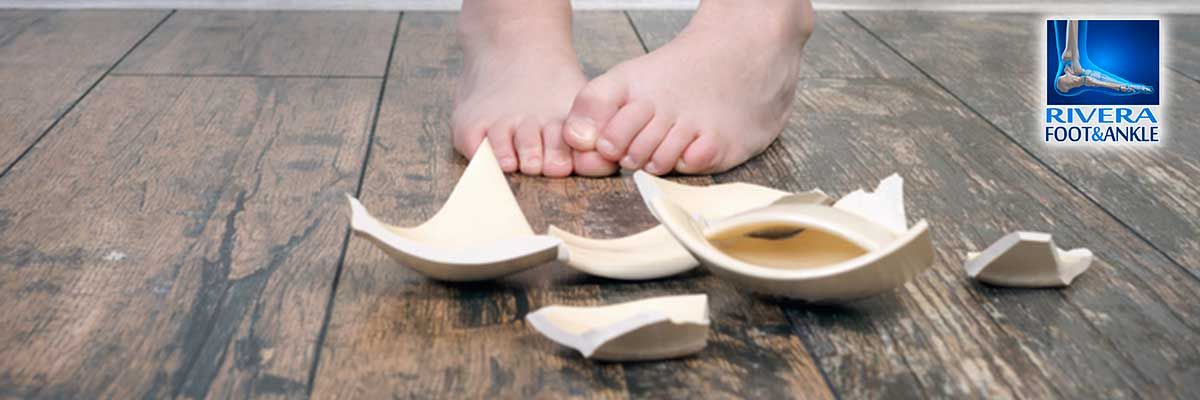
The Diabetic Foot and Risk:
How to Prevent Losing Your Leg
Don't deny you are a diabetic
Anyone who has ever had an elevated blood sugar level is at risk for foot complications. It may be as simple as knowing that once in your life, even during pregnancy, you have had an elevated blood sugar level. If so, you are at risk and must monitor your feet.
Diet-controlled diabetics, whether diagnosed as an adult or as a child, have feet at risk of diabetic complications. The simple rule: If you have ever been told that you are at risk of developing diabetes, you need to consider your feet and work to prevent injury.
Don't accept that all diabetics lose their legs
It starts with daily foot checks: inspecting all sides, including the bottoms, which can be done best with someone's help or with a mirror. During a foot check, any changes in the foot's shape or color, sense of feeling/sensation, painful areas or skin integrity need to be evaluated. Any new bunions, calluses or corns need to be identified and shown to a medical doctor.
The overall foot shape could change due to a bone fracture that would also need the attention of a physician. Stress fractures are very small breaks in the bone that will not usually change the shape of the foot, but may cause pain, bruising or swelling. The color of the foot is important as it helps show any changes in blood flow to the foot. Darkening or loss of hair may indicate that the blood or nerve supply has decreased. Less blood to the foot can mean slower healing of cuts and scrapes.
Bruises indicate injuries. Especially important are the bruises or cuts found during a foot check that the person was not aware of at the time of injury. Any bruises within calluses are particularly important to show to a physician.
To monitor sensation, a feather or facial tissue can be used to brush the foot and test its ability to feel light touch. It is also important to be sure the foot can sense the differences between hot/warm and cold water. Shower water can be first tested with the hand and then with the feet to identify any loss of temperature sensation.
Testing for any change in ability to "feel" with the feet is important because diabetics can hurt themselves and not be aware of the injury or its severity. By checking their feet daily, they can see any new wounds and monitor healing areas.
Diabetics should wear more protective shoes, not sandals, to prevent any injuries to the feet and toes. The foot may not feel "numb," but a progressive decrease in ability to feel light touch, temperature or the presence of shoes indicates a foot at risk. The loss of vibrating and touch sensation is gradual and easy to ignore, but it is the single most important feature to identify with regard to avoiding amputation.
Beware of Common Pitfalls
Any areas that are painful need to be examined very closely for any of the above-mentioned changes. Foot injuries that occur without the person's knowledge can be the first sign of diabetes, especially when accompanied with decreased sensation.
Wounds need to be monitored. When wounds take a long time to heal, the foot becomes at risk of infection, ulcers and further damage to local tissue and bone. There are special bandaging techniques and ointments that can be used to help diabetic wounds heal and concurrently prevent permanent damage.
As with any chronic disease, history is important, both the patient's and his or her family's. Diabetics who have had problems with any of the following (in the past or currently) need to consider themselves at risk: foot ulcers, toenail infections such as fungus, stress fractures or other single fractures of the foot, slow-healing wounds, bunions, corns and thick calluses. In the family history, any amputations of toes, feet or legs (part or whole) need to be shared with a physician. Other family members with known diabetes, suspected diabetes or problems with the feet such as mentioned above should be shared with a physician.
The bottom line is take care of your feet, look at them daily and see a medical doctor if anything is suspicious. It is important to be evaluated by a medical doctor (MD/DO) with an adequate breadth of training to determine an accurate diagnosis of your problem. Consideration of competing diagnoses, such as vitamin deficiencies, genetic conditions, or spinal or neurologic conditions is important to your successful care.
Source: aofas
RIVERA FOOT & ANKLE: At Orlando H.Rivera DPM, our priority is to deliver quality care to informed patients in a comfortable and convenient setting. When you have problems with your feet, you need to turn to a podiatrist who listens and responds… an experienced doctor who knows the field and can effectively diagnose and treat your needs… a friendly physician who counsels you on the best ways to maintain and improve your health. Our physician(s) meet all these criteria. Plus, you benefit from a dedicated team of trained professionals who give you the individualized attention you deserve.

Diabetic Foot Specialist in Houston
Foot and Ankle, Dr. Orlando Rivera, Advanced Foot & Ankle Specialist, Foot and Ankle Podiatry, Houston Foot & Ankle Surgical, Treatment of Foot and Ankle, Foot & ankle specialists, Podiatrist in houston, podiatrist in houston, Orlando H.Rivera DPM, Houston Foot Doctor, Foot and Ankle Surgeon Houston, Ankle and Foot Specialist Houston, Podiatrist Houston, Foot Pain Houston.



